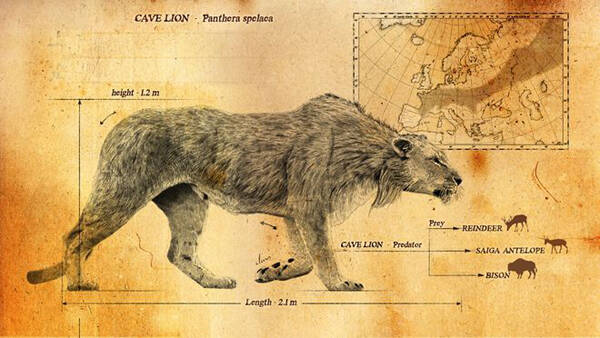Panthera leo spelaea
IUCN
LCBasic Information
Scientific classification
- name:Panthera leo spelaea
- Scientific Name:Panthera leo spelaea,Felis leo major,European cave lion, Eurasian cave lion
- Outline:Carnivora
- Family:Schizopoda Felidae Panthera
Vital signs
- length:2.7-3m
- Weight:About 250kg
- lifetime:No verification information
Feature
Prehistoric beasts that once lived in Siberia
Distribution and Habitat
They lived in Eurasia during the Middle and Late Pleistocene, ranging from Britain to the Russian Far East. They were also active in Alaska and northwestern Canada.
Between 300,000 and 100,000 years ago, cave lions were found in the steppes and desert and semi-desert areas of northern and central Eurasia. However, it is clear that they were not well adapted to dense forests or deep snowfields. Cave lion fossils are found in Europe as far west as the British Isles and as far east as the Alazeya River Basin in Siberia.
Appearance
Cave lions have thick limbs, with a total length of up to 3 meters and a weight of 250 kilograms. They are taller than ordinary tigers and far better than any other lion. In ancient times, the shoulder height could reach about 1.2 meters, and the skull was about 45 centimeters. Larger than any modern lion. Cave lions have round, protruding ears, a tufted tail, and may have faint tiger-like stripes, at least on their neck and rump. Other archaeological artifacts indicate they were used in Paleolithic religious rituals. Cave lions are ferocious big cats with cantankerous and lonely personalities. Their images have appeared in the rock paintings and carvings of European ancestors in the Stone Age. These oldest human artworks have also become precious materials in the hands of scientists. Based on these, it can be seen that there are faint markings on their fur. The male cave lion also has a ring-shaped mane on its neck, but it is far less conspicuous than that of the African lion.
The
Details
Cave lion (scientific name: Panthera leo spelaea) synonymous scientific name Felis leo major, also known as European cave lion, is an extinct cat species, a close relative of modern lions, but larger in size.

Cave lion originated from a large cat species that lived in Africa in the early Pleistocene - the fossil lion. By 500,000 years ago, fossil lions were widely distributed in the east and south of the African continent. Fossil records show that some of them began to "walk out of Africa" and evolve independently. The members that entered northeastern Asia evolved into Yang's tiger, while the fossil lions that entered Europe adapted to the mountainous and relatively cold climate and the composition of prey, and their body size further increased, evolving into a new subspecies - cave lion.
Compared with today's African lions, all parts of the cave lion's body have increased accordingly, except for the shorter tail. They are 25%-35% larger than ordinary African lions on average, and their bodies and limbs are also thicker, making them look unusually sturdy. The largest male cave lion is 3.8 meters long and up to 1.4 meters tall at the shoulder, which is larger than the Siberian tiger and various extinct saber-toothed tigers. It is the largest cat in history (except for artificially "manufactured" ligers). Their images have appeared in the rock paintings and carvings of the European ancestors in the Stone Age. These oldest human artworks have also become valuable materials in the hands of scientists. According to these, it can be seen that there are faintly visible stripes on their fur, and the male cave lion also has a ring-shaped mane on its neck, but it is far less obvious than that of the African lion.
It is generally believed that due to its large body and small number of prey, cave lions may not form a large group of more than ten or twenty like African lions, but may form small groups, pairs or even live alone. The underdeveloped mane of male cave lions as a secondary sexual characteristic may be related to the fact that their social behavior is not as frequent as that of African lions. Their main prey may be horses, camels, mammoth cubs and various types of bison.
According to records, cave lions became extinct when the last glacier disappeared 10,000 years ago. The reason was that they were hunted in large numbers for competing with humans for caves as nests, and the large European wild horses that were their main food became extinct, so the cave lions became extinct.
Scientists have found two well-preserved cave lion cubs dating back 12,000 years in the permafrost of Siberia. The two cave lion cubs are very well preserved. In March 2016, scientists announced that they were trying to clone this long-extinct mammal. The cave lion remains were found in the Sakha Republic of Russia, about 1,050 kilometers from the capital Yakutsk. The research team from South Korea hopes to revive the pair of cave lions. They have previously studied how to revive real mammoths. Scientists called the two "perfectly preserved" predators - named Uyan and Dina - "very exciting discoveries". Controversial South Korean biologist and cloning expert Hwang Woo-suk travelled to Yakutsk to discuss with local scientists the removal of some skin and muscle tissue from a cave lion cub. The remains of one of the cubs are stored in a freezer in Russia indefinitely awaiting the advent of more advanced cloning technology.
Protect wildlife and stop eating game.
Maintaining ecological balance is everyone's responsibility!








